Friday, November 27, 2009
Friday's Favorite OTR
A professional magician is sentenced to death for committing a murder--but he vows to return from the grave to take revenge on the judge, the DA and all twelve jurors. Sure enough, a month after his execution, someone strangles the jury foreman.
The Mysterious Traveler is one of those shows that normally has a "rational" explanation for supposed supernatural events (though they did delve into science fiction from time to time). This one manages to keep you guessing right up to the end, though--making you think that maybe this time there is a supernatural explanation for the whole thing. There's several possible twists the plot can take at the tense climax and many listeners probably won't guess just which way that final twist will take us. I didn't, at least.
Click HERE to listen or download.
Thursday, November 26, 2009
Who the heck IS on first, anyways?
"Who's on First" is still, in my opinion, the funniest comedy routine in the history of the universe.
Abbott and Costello were veterans of vaudeville. Gee whiz, I miss vaudeville. I'm not old enough to actually remember it--but I miss it. It was an extraordinary training ground for comedians. Aside from Bud and Lou, guys like Jack Benny, George Burns and Gracie Allen, the Marx Brothers and Bob Hope learned their trade by playing a zillion small-time theaters in a zillian towns and cities. When they brought what they learned to radio and the movies (and eventually television), they all regularly brought the house down.
Comedian Fred Allen wrote an autobiography about his years in vaudeville called Much Ado About Me. It is informative and hilarous and not a little bit heartbreaking in its portrayal of a bygone era. In fact, there's a chapter late in the book in which he breaks away from his narrative to compose what is basically a love letter to vaudeville, filled with priceless anecdotes about his fellow performers. It's one of the reasons I miss vaudeville so much--even though it died away before I was born.
By the way, I've got the above clips and 50 or so others posted in one convenient location HERE.
Wednesday, November 25, 2009
History of theMarvel Universe: June 1964, part 3
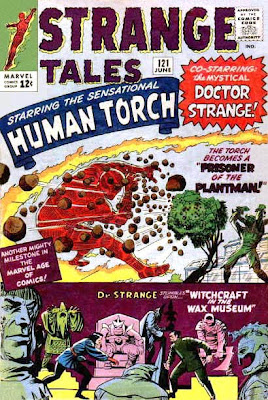 STRANGE TALES #121
STRANGE TALES #121The Plantman--the villain able to endow plants with intelligence and then control their actions--returns for another crime spree and, incidentally, to take revenge on Johnny for defeating him back in Strange Tales #113.
Johnny spends a lot of time in this issue getting dunked in water or soaked with enough dew to put out his flames, but he manages to get the upper hand in the end and the Plantman is hauled off to the hoosegow.
This is a pretty average tale that doesn't generate a lot of comment. There is one really cool panel that deserves mention, though. The image of a small tree sneaking into Johnny's bedroom carrying a bucket of water is alone worth the price of admission.
Dr. Strange, in the meantime, is tricked into assuming his ectoplasmic form and leaving his body behind to answer a faked call for help. This allows Mordo to steal and hide Strange's physical form. Strange has only a short time to find the body again and reoccupy it before he fades into nothingness.
It's a neat idea and Ditko's art work--including scenes of an ectoplasmic Dr. Strange battling weird beasties and a final confrontation with Mordo in a wax musuem--make this another strong entry in the series.
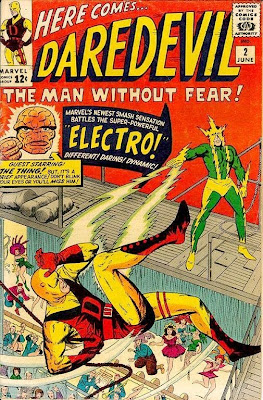
DAREDEVIL #2
Well, Daredevil (unlike Spider Man) seems to be in no particular hurry to get his own Rogue's Gallery. In this issue, he borrows one of Spidey's many sparring partners.
This issue also pretty shamelessly plugs other Marvel titles--but does so in ways that make story sense, so it's all perfectly acceptable. The Fantastic Four hire Matt Murdock to read over the new lease at the Baxter Building. So when the FF leaves for a trip to Washington and Electro breaks into their HQ to steal a scientific secret or two, Matt is on hand to battle the villain.
The fight is pretty heavy in the use of thought balloons, allowing Stan Lee to detail how Daredevil uses his super-senses to stay on top of the fight. ("Sounds of... "flickering lights... tickets being torn and changing hands... Electro is racing into a movie theater!") This does the job of effectively letting us know how the hero operates, but it does slow the action down a little. Later issues will find a better balance to the action scenes.
That's it for June. July 1964 will find the Fantastic Four meeting the X-Men; Spider Man adding a very important villain to his Rogue's Gallery, then paying a visit to Tales to Astonish to encounter Giant Man; Thor and Iron Man finishing their respective two-parters; the Human Torch encountering some obscure villains left over from an FF story; Dr. Strange having a rematch with Nightmare; the Avengers battling a supervillain group for the first time; and the X-Men tussling with the Sub-Mariner.
Friday, November 20, 2009
Friday's Favorite OTR
The bad guys in this one are actually kinda creepy. When we meet them at the beginning of the episode, they seem like a normal young man and his girl happily in love with each other. She's making him try to guess what her birthday present to him is. When it turns out to be a mask--for use in his armed robbery business--we rather abruptly get the idea that this pleasant young couple have some seriously sociopathic tendencies.
Anyway, the guy's next robbery attempt goes awry and results in a murder. His getaway car--driven by a friend--crashes. The friend is killed and mistaken by the police for the actual killer.
But Philo Vance isn't satisfied. He picks up a couple of subtle clues that indicate there was a second person in the car. Then, using a cheese cake found in the car as a starting point, he manages to track down the real killer.
The original Philo Vance novels have dated badly and--in the books--he's the world's most annoying character. But on radio, played with a mixture of intelligence and affability by Jackson Beck, Vance was an effective hero. And the plots, like this one, were well-constructed mysteries. Put a likeable main character into a good mystery and you almost can't help but be entertaining.
This episode can be downloaded. HERE.
Thursday, November 19, 2009
Well, HE'S looking at a serious case of sunburn, isn't he?
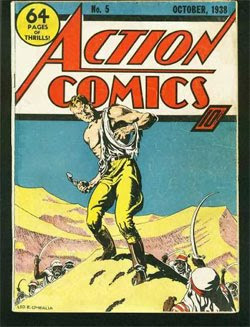 This is the cover for Action Comics #5, with a November 1938. At this point, Action was an anthology book, featuring a variety of 6-page and 8-pages stories in each issue--including those featuring a new-fangled character named Superman.
This is the cover for Action Comics #5, with a November 1938. At this point, Action was an anthology book, featuring a variety of 6-page and 8-pages stories in each issue--including those featuring a new-fangled character named Superman.Of course, the Last Son of Krypton proved to be enormously popular, kick-starting the dominance of super-hero characters in comic books. But only a few of the early Action Comics covers featured Superman. No one at DC Comics really expected him to be so incredibly popular.
And this is just as well--since the result was great covers like this. By the time Action Comics was into its second year, Superman was the regular subject on the covers. That's fine by itself, but it's nice that guys like the poor slob above had a chance to get their moments of glory. This is an excellent example of effective illustration--it really gives us a sense of immediate danger. I especially like the care the artist (Leo O'Mealia) took to include details like footprints on the sand and the hero's shadow stretched out behind him.
Wednesday, November 18, 2009
History of the Marvel Universe: June 1964, part 2
 JOURNEY INTO MYSTERY #105
JOURNEY INTO MYSTERY #105Mr. Hyde and the Cobra, defeated by Thor individually, decide to try working together to take revenge against the Thunder God.
Both characters were too underpowered to represent a decent threat to Thor in previous issues. Together, they make a slightly more believable threat. Mr. Hyde comes up with some scientific gadgets to even the odds a bit--including a nifty "time reversal ray" that allows them to backtrack Thor and discover he has some sort of connection with Donald Blake. The villains also make good use of a sort of tag-team approach their direct attacks, making it difficult for Thor to capture one before the other steps back into the fight.
There's one weak moment. Hyde and Cobra capture Blake to lure Thor to them. The trick Blake uses to get them to help him turn into Thor--while their backs are turned so they don't notice the transformation--was a little too contrived to be acceptable.
The story continues into the next issue. (Two-parters are slowly starting to become more common among the various Marvel books). It concludes this issue with an interesting take on how the magic inherent in Thor's hammer works. No other living being can lift it unless they are worthy, right? But can a significantly strong machine lift it? Apparently so--as Cobra uses an atomic-powered hydraulic lift to snatch it from Thor's grasp.
I wasn't sure if I liked this at first, but after thinking about it a moment, the idea grew on me. An inanimate object can't be either worthy or unworthy, so it can be argued that it is exempt from the hammer's usual magic.
The back-up story involves enemies of Asgard using a small sprite-like "air creature" to sneak past Heimdall and scout out Asgard's defences. As usual, it's Jack Kirby's magnificent art that sells this short and fairly quiet tale.
-
Thursday, November 12, 2009
A nifty montage of pulp SF covers
Wednesday, November 11, 2009
History of the Marvel Universe: June 1964: part 1
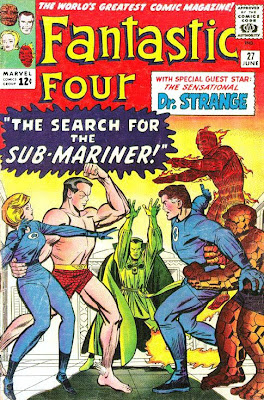 FANTASTIC FOUR #27
FANTASTIC FOUR #27Reed finally decides to propose to Sue. But while he's out buying a ring, Namor shows to kidnap the poor girl yet again. The undersea prince, still deserted by his people save for the few loyal guards who rejoined him in Avengers #4, has decided that he needs a bride to regain his previous glory.
Reed pretty much explodes with anger and decides that he'll confront Namor alone. Johnny and Ben don't approve of this, so they recruit Dr. Strange to track down Namor so they can rejoin Reed in time to help.
What follows is yet another great fight scene--Reed goes mano-o-mano with Namor while Ben handles the contingent of Atlantean soldiers. Johnny rescues Sue and they work together to ward off a death trap or two. Cuts between the various scenes are expertly handled so we can easily follow the action throughout.
And Jack Kirby does a great job of making the fight between Namor and Reed believable, with Reed using his powers in several clever ways to cancel out Namor's advantage in pure power. A panel in which Reed forms his body into a giant crossbow and basically fires Namor into some of his own soldiers is wonderful. It somehow manages to be just a little bit silly and really cool at the same time.
Anyway, Sue seperates everyone with a force field and tells Namor to leave her alone in the future. This ticks the pointy-eared prince off, but Dr. Strange teleports everyone away before the fighting can resume. But poor Reed thinks Sue might have just been pretending to reject Namor to end the conflict. So no proposal yet.
I do like the nod to the Marvel Universe's internal continuity here. Namor was rejoined by some of his solders in the Avengers, but Stan Lee remembered to carry that event over into the Fantastic Four. And, finally, Reed angry reaction to Namor's actions adds some real depth to his character.
Spider Man is still adding to his Rogue's Gallery at a fast and furious pace. This month introduces us to Mysterio, a former stunt man/special effects guy who uses his skills and devices to frame Spider Man for a series of robberies. Mysterio then publically sets himself up as a crime fighter and the only guy who can bring the villianous webslinger to justice.
Peter spends a few pages worried that he has developed a split personality and really is committing the crimes. This part of the story doesn't really work--this isn't the first time Spidey's been impersonated, after all.
And when Spider Man finally figures out what is going on, he uses the already cliched method of getting the bad guy to gloat and openly confess his crimes while Spidey gets it all on tape.
These flaws keep this issue from being as good as Spider Man usually is, but it's still not bad stuff. Ditko gives us another fine fight scene--he continues to show a real talent for choreographing the action in such a way that emphasizes the webslinger's need to use his brains as well as his powers to win. And Mysterio is a great villain who will be put to better use in better constructed stories in the future.
That's it for this week. Next time, we'll look in on Thor, Iron Man and Giant Man.
Thursday, November 5, 2009
If it's 9 o'clock, then he's up with the orchids.
It's always a lot of fun to spend some time with Nero Wolfe and Archie Goodwin. The two play off each other so well. In fact, the two men do a remarkable job of combining the traditional whodunit with the hard-boiled detective genre.
The obese but brilliant Wolfe represents the traditional detective. "I have no talents," he once said. "I have genius or nothing!" So he becomes a private investigator, using his genius to earn often very high fees.
Archie represents the hard-boiled P.I. When Wolfe takes a case, it's Archie who does the footwork, collecting facts and interviewing witnesses. Archie is a skilled detective in his own right, quite able to make intelligent decisions while out on his own. But it's Wolfe who puts all the facts together and solves the case.
But it's the prose and the dialouge of the Wolfe stories that really make them the classics they are. Wolfe and Archie are also just plain fun to listen to. Wolfe's grammatically precise sentences, peppered with obscure words, nicely counterpoints Archie's cynical wit. And Rex Stout's excellent storytelling skills allow the sometimes complex plots to unfold in a staightforward and intelligent fashion.
Wolfe and Archie are perfect partners, but often get on each other's nerves. That's pretty much how they got involved in solving a trio of murders in The Golden Spiders. Wolfe had gotten into a snit when his personal chef unexpectedly changed a recipe for the main course at dinner. This leads Archie to decide that Wolfe needs to be taught a lesson.
So when a 12-year-old boy shows up on the doorstep, demanding to see Wolfe, Archie lets him in. But Wolfe gets back in turn at Archie by politely listening to the boy (who thinks he's seen a woman in danger) and obligating Archie to forgo a night out to take notes.
Everything gets a bit more serious the next day when the boy is murdered. A couple of other deaths follow and an odd chain of circumstances (and a $10,000 check) obligate Wolfe to investigate.
What follows is an expertly constructed mystery with a satisfying conclusion. The novel also includes some great scenes with some of the series' regular supporting characters, including the perpetually aggravated Police Inspector Cramer and the three independent private eyes (Saul Panzar, Orrie Cather and Fred Durkin) often hired by Wolfe when they need more help on a case. It all comes to an end, as it usally does, in Wolfe's study, with the corpulant genius explaining to a roomful of suspects and cops who killed whom. It's a great novel from start to finish--one of the best of the series.
Next month, we'll visit with P.I. Philip Marlowe in Raymond Chandler's The High Window.
Wednesday, November 4, 2009
History of the Marvel Universe: May 1964, part 3
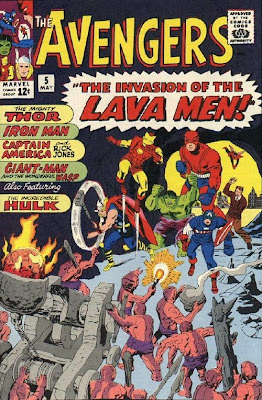 AVENGERS #5
AVENGERS #5The subterranean race known as the Lava Men (Thor fought one of them in his own book several months ago) have a problem. A big chunk of unstable and explosive "living rock" is growing rapidly inside their kingdom. If it goes off, it'll blow up the planet.
Their solution? Push the rock to the surface, where it'll only take out all us annoying surface dwellers. The rock happens to appear in the American Southwest, near where Bruce Banner has recently returned to work for the Army.
So he's nearby when the Avengers show up to investigate. The bulk of this issue is a battle between the Avengers and the Lava Men, with the Hulk appearing near the end. The Avengers manage to trick the Hulk into helping to harmlessly destroy the living rock.
It's a pretty good issue with Kirby's usual well-choreographed action sequences. There's a couple of other notable points:
a) The various Marvel comics continue to build a strong internal continuity. This one, for instance, picks up right after the events in Fantastic Four #26, with the Avengers taking stock of damage to their headquarters done by the Hulk. And it's a way of building continuity that is perfectly fair to the reader--if you haven't read FF #26, you haven't missed anything you need to know to follow this story.
b) This is the Hulk's last regular appearance in the Avengers. The big green guy will pop up in Spider Man in a couple of months and finally get his own series again as part of Tales to Astonish in four months--the start of a long-running series that will mark him as one of Marvel's most important characters.

X-Men #5









